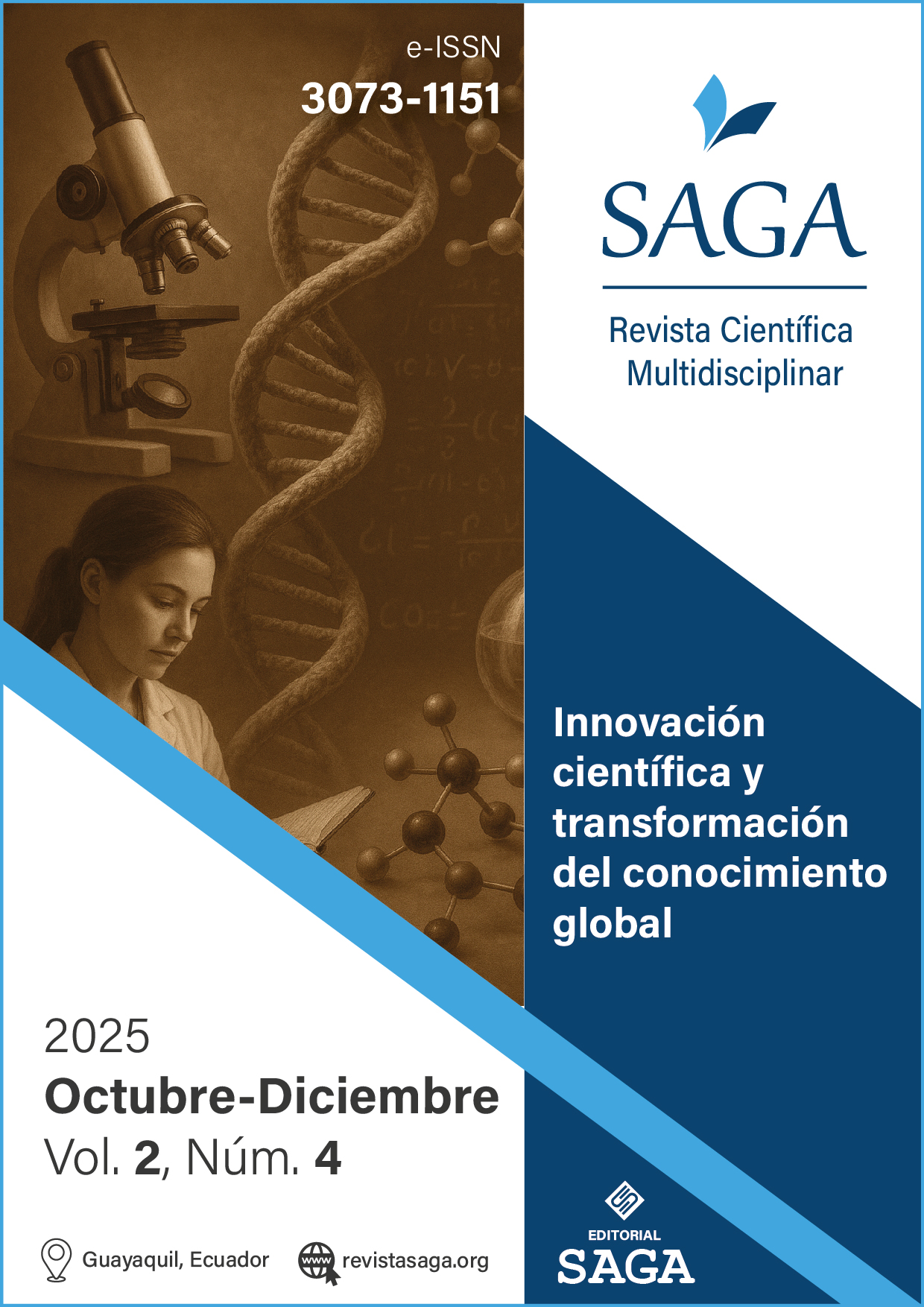Mezcla proteica con arándanos (Vaccinium corymbosum), granos andinos y Sacha Inchi (Plukenetia volubilis)
DOI:
https://doi.org/10.63415/saga.v2i4.290Palabras clave:
ácidos grasos, dispersibilidad, humectabilidad, kiwicha, quinuaResumen
Sacha inchi es conocida como el maní de los incas, con propiedades nutricionales destacables como los ácidos grasos omegas 3 y 6, además de un alto contenido en proteína (56.61%). Los granos andinos conocidos en todo el mundo como “super foods” contienen aminoácidos esenciales completos, proteínas de alta digestibilidad, y compuestos bioactivos. El objetivo fue elaborar una mezcla proteica con arándanos, harina de quinua (HQ) y harina de kiwicha (HK) y harina de sacha inchi (HSI). Se realizaron 4 formulaciones F1 (5% HSI, 15% HQ, 25% HK), F2 (10% HSI, 10% HQ, 25% HK), F3 (15% HSI, 10% HQ, 20% HK) y F4 (25% HSI, 10% HQ, 10% HK). Se analizó la composición proximal, propiedades fisicoquímicas (pH, acidez, °Brix), índice de estabilidad, humectabilidad, dispersibilidad y atributos sensoriales. Los resultados mostraron un contenido alto de proteína de 20.94% del F4, además de contenidos altos de lípidos de 10.01% a 13.62%, con baja humedad de 5.25%. Los resultados de la evaluación sensorial demostraron la mayor aceptación para el F2 con 8.07 y puntuación del atributo del sabor con un 7.99. Se elaboró una mezcla proteica novedosa y saludable con un efecto sinérgico en sus ingredientes.
Descargas
Referencias
Abellán, M. S., Barnuevo, M. D., García, C., Contreras, C. J., Aldeguer, M., Soto, F., Guillén, I., Luque, A. J., Quinde, F. J., Martínez, A., López, F.J. (2017). Effect of quinua (Chenopodium quinoa) consumption as a coadjuvant in nutritional intervention in prediabetic subjects. Nutricion Hospitalaria 34 (5):1163–9. https://doi.org/10.20960/nh.843.
Abugoch, James, LE. (2009). Quinoa (Chenopodium quinoa Willd.): Composition, chemistry, nutritional, and functional properties. 1 ed. s.l., Elsevier Inc., (58): 1-31. https://doi.org/10.1016/S1043-4526(09)58001-1.
AOAC. (2005). Official Methods of Analysis, eighteenth ed. AOAC International, Gaitherseburg.
Atmaca, G. (2004). Antioxidant effects of sulfur-containing amino acids. Yonsei Med. J. 45, 776-88
Becker, R., E. L. Wheeler, K. Lorenz, A. E. Stafford, O. K. Grosjean, A. A. Betschart, and R. M. Saunders. (1981). A composition study of amaranth grain. Journal of Food Science 46 (4):1175–80. https://10.1111/j.1365-2621.1981.tb03018.x.
Bianchi, F; Rossi, E; Gomes, R; Sivieri, K. (2015). Potentially synbiotic fermented beverage with aqueous extracts of quinoa (Chenopodium quinoa Willd) and soy. Food Science and Technology International 21(6):403-415. https://10.1177/1082013214540672
Bressani, R. (1994). Composition and nutritional properties of amaranth. In: Paredes- Lopez. Amaranth - biology, chemistry, and technology. CRC Press, London, 185-206.
Choque-Delgado, G., Carlos Tapia K., Pacco-Huamani, M. & Hamaker, B. (2022): Peruvian Andean grains: Nutritional, functional properties and industrial uses, Critical Reviews in Food Science and Nutrition, https://10.1080/10408398.2022.2073960
Christophe, J., Tan C., Wasoh, H., Lai, OM. (2023). Comparative study of thermal pre-treatment on the extraction, antioxidant, fatty acid profile, and physicochemical properties of inca inchi seed oil. Pertanika J. Trop. Agr. Sci., 46, 909-30.
Dag, D.; Singh, R.K.; Kong, F. (2022). Developments in Radio Frequency Pasteurization of Food Powders. Food Rev. Int. 38,1197–1214.
Durand, A, Franks, G, Hosken, R. (2003). Particle sizes and stability of UHT bovine, cereal and grain milks. Food Hydrocoll 17: 671-678.
Estupiñan-Amaya, M.; Fuenmayor, C.A.; López-Córdoba, A. (2023). Exploring the Potential of Wild Andean Blueberries for Powdered Juice Production through Spray Drying. Foods, 12, 2348. https:// doi.org/10.3390/foods12122348
Fang Y., Y. Selomulya Y., Ainsworth S., Palmer M., Chen X.D., (2011). On quantifying the dissolution behaviour of milk protein concentrate, Food Hydrocoll. 25: 503–510, https://doi.org/10.1016/j.foodhyd.2010.07.030.
Fang, C., Wang, Q., Liu, X. and Xu, G. (2017). Metabolic profiling analysis of Siraitia grosvenorii revealed different characteristics of green fruit and saccharified yellow fruit. Journal of Pharmaceutical and Biomedical Analysis, 145:158-168.
FDA – Food and Drug Administration. (2021). Etiqueta de información nutricional interactiva. Octubre. Estados Unidos.
Fournaise, T., Burgain, J., Perroud, C., Scher, J., Gaiani, C., Petit, J. (2020). Impact of formulation on reconstitution and flowability of spray-dried milk powders, Powder Technol. 372:107–116, https://doi.org/10.1016/j.powtec.2020.05.085
Fournaise, T., Petit, J., & Gaiani, C. (2021). Main powder physicochemical characteristics influencing their reconstitution behavior. Powder Technology, 383, 65-73.
Freudig, B., Hogekamp, S., Schubert H. (1999). Dispersion of powders in liquids in a stirred vessel, Chem. Eng. Process. Process Intensif. 38 (1999) 525–532, https://doi.org/10.1016/S0255-2701(99)00049-5.
Fu, X. Huck, D. Makein, L. Armstrong, B. Willen, U., Freeman. T. (2012). Effect of particle shape and size on flow properties of lactose powders, Particuology. 10:203–208, https://doi.org/10.1016/j.partic.2011.11.003.
García, M., A., & Pacheco, D.E. (2010). Evaluación de una bebida láctea instantánea a base de harina de arracacha (Arracacia xanthorrhiza) con la adición de ácido fólico. Revista Chilena de Nutrición, 480-492.
Guillen, M., Ruiz, A., Cabo, N., Chirinos, R., Pascual G. (2003). Characterization of sacha inchi (Plukenetia volubilis L.) oil by FTIR spectroscopy and 1H NMR. comparison with linseed oil. J. Am. Oil Chem. Soc. 80, 755-62.
Hajiaghaei, M., & Sharifi, A. (2022). Physicochemical properties of red beetroot and quince fruit extracts instant beverage powder: Effect of drying method and maltodextrin concentration. Journal of Food Quality. (1), 7499994.
Hardiyanto, Y. F., Saputro, A. D., Nurkholisa, Z., Setiyadi, P. A., Bintoro, N., & Kusuma, R. A. (2021). The effect of steaming time and types of cocoa powder on the characteristics of instantized cocoa powder made using batch-type steam jet agglomerator. In IOP Conference Series: Earth and Environmental Science (Vol. 653, No. 1, p. 012089). IOP Publishing.
Haros, C. M., Martínez, M. L., Agostini, B. V., & Muñoz, L. A. (2023). Food uses of selected ancient grains. In Latin-American Seeds (pp. 259-302). CRC Press.
Hinds, MJ; Beuchat, LR; Chinnan, MS. (1997). Effects of homogenization pressure and stabilizers on some physical characteristics of a beverage prepared from partially defatted, roasted peanuts. Plant Foods for Human Nutrition 50(4):269-277. https://doi.org/10.1007/BF02436073
Hogekamp, S., Schubert, H. (2003). Rehydration of food powders, Food Sci. Technol. Int. 9, 223–235, https://doi.org/10.1177/1082013203034938.
IBO – International Blueberry Organization. (2024). Perú proyecta alcanzar las 323.928 toneladas de arándanos exportados en 2024/2025. https://www.internationalblueberry.org/2024/12/18/peru-proyecta-alcanzar-las-323-928-toneladas-de-arandanos-exportados-en-2024-2025/
Idexcam. (2017). Elaborado por el Instituto de Investigación y Desarrollo de Comercio Exterior – IDEXCAM – de la Cámara de Comercio de Lima. Cámara de Comercio de Lima. https://www.camaralima.org.pe/wp-content/uploads/2020/06/Opertunidades-y-retos-en-la-exportaci%C3%B3n-de-ar%C3%A1ndanos.pdf
IDF. (1987). Détermination de la dispersibilité et de la mouillabilité, International Dairy Federation, Brussels, Belgium.
Jouki, M., Khazaei, N., Rashidi-Alavijeh, S., & Ahmadi, S. (2021). Encapsulation of Lactobacillus casei in quince seed gum-alginate beads to produce a functional synbiotic drink powder by agro-industrial by-products and freeze-drying. Food Hydrocolloids, 120, 106895.
Karimova, N. Yu., Alekseenko, E. V., & Shanenko, E. F. (2025). Development of a powdered concentrate for a non-alcoholic beverage based on sublimated blueberry juice. Food systems, 244.
Lamothe, L. M., S. Srichuwong, B. L. Reuhs, and B. R. Hamaker. (2015). Quinoa (Chenopodium quinoa W.) and amaranth (Amaranthus caudatus L.) provide dietary fibres high in pectic substances and xyloglucans. Food Chemistry 167:490–6. https://10.1016/j.foodchem.2014.07.022.
Li, L., G. Lietz, W. Bal, A. Watson, B. Morfey, and C. Seal. (2018). Effects of quinoa (Chenopodium quinoa Willd.) consumption on markers of CVD risk. Nutrients 10 (6):777. https://10.3390/nu10060777
Lie-Piang, A., Leeman, M., Castro, A., Börjesson, E. and Nilsson, L. (2021). Investigating the effect of powder manufacturing and reconstitution on casein micelles using asymmetric flow field-flow fractionation (AF4) and transmission electron microscopy, Food Res. Int., 139, 109939
Ligarda, S., C. A. Repo-Carrasco, R. Encina, Z. C. R. Herrera, and B. I. Z. Quinde-Axtell. (2012). Neutral and alkaline extractions methods for the isolation of soluble and insoluble fibers brans from quinoa (Chenopodium quinoa Willd.), kiwicha (Amaranthus caudatus L.) and cañihua (Chenopodium pallidicaule Aellen). Revista de la Sociedad Química Del Perú 78 (1):53–64.
Lipan, L., Rusu, B., Simon, E. L., Sendra, E., Hernández, F., Vodnar, D. C., Corell, M. & Carbonell‐Barrachina, Á. (2021). Chemical and sensorial characterization of spray dried hydroSOStainable almond milk. Journal of the Science of Food and Agriculture, 101(4), 1372-1381.
Liu, S.; Roopesh, M.S.; Tang, J.; Wu, Q.; Qin, W. (2022). Recent development in low-moisture foods: Microbial safety and thermal process. Food Res. Int. 155, 111072.
Livesey, G. (1987). Energy and protein requirements the 1985 report of the 1981 Joint FAO/WHO/UNU Expert Consultation. Nutrition Bulletin, 12(3), 138-149.
Kim, D-M, Lee, H, Yoo, S-H. (2012). Compositional changes and physical properties of soymilk prepared with pre-soaked-fermented soybean. J Kor Soc App Bio Chem 55:121–126.
Mahalakshmi, M.; Meghwal, M. (2023). Microencapsulation of Fruit Juices: Techniques, Properties, Application of Fruit Powder. J. Food Process Eng., 46, e14226.
MINSA – Ministerio de Salud. (2006). R.M. N° 451-2006/MINSA “Norma Sanitaria para la Fabricación de Alimentos a Base de Granos y otros, destinados a Programas sociales de Alimentación”. Perú.
Mimouni, A., Deeth, H.C., Whittaker, A.K., Gidley, M.J., Bhandari, B.R. (2010). Investigation of the microstructure of milk protein concentrate powders during rehydration: alterations during storage, J. Dairy Sci. 93:463–472, https://doi.org/10.3168/jds.2009-2369.
Mounika, S., Saipranavi, M., Swamy, R., & Prasad, J. S. (2021). Production of Fruit Powders and Formulation of Instant Probiotic Fruit Powders Mix. Biological Forum – An International Journal, 13(4). 1224-1231pp.
Nascimento, AC; Mota, C; Coelho, I; Gueifão, S; Santos, M; Matos, AS; Gimenez, A; Lobo, M; Samman, N; Castanheira, I. (2014). Characterization of nutrient profile of quinoa (Chenopodium quinoa), amaranth (Amaranthus caudatus), and purple corn (Zea mays L.) consumed in the North of Argentina: Proximates, minerals and trace elements. Food Chemistry 148:420-426. https://doi.org/10.1016/j.foodchem.2013.09.155
National Academy of Sciences. (2004). Comprehensive DRI table for vitamins, minerals and macronutrients, organized by age and gender. Institute of Medicine. Food and Nutrition Board, Beltsville, MD.
Navruz-Varli, S; Sanlier, N. (2016). Nutritional and health benefits of quinoa (Chenopodium quinoa Willd.). 69. https://doi.org/10.1016/j.jcs.2016.05.004.
Nowak, V., Du, J., Charrondière, R. (2016). Assessment of the nutritional composition of quinoa (Chenopodium quinoa Willd.). Food Chemistry. 193: 47–54. https://doi.org/10.1016/j.foodchem.2015.02.111
O’Mahony, J.A., McSweeney P.L.H. (2016). Advanced dairy chemistry, Proteins: Applied aspects, Fourth edition, Volume 1B, Springer, http://125.234.102.149:8080/dspace/handle/DNULIB_52011/7900
Organización de las Naciones Unidas para la Alimentación y la Agricultura - FAO – Comité de expertos. (1993). Importancia de las grasas y aceites para el crecimiento y desarrollo de los niños. https://www.fao.org/4/t4660t/t4660t05.htm#:~:text=Para%20los%20lactantes%20menores%20de,asegurar%20una%20ingesta%20energ%C3%A9tica%20adecuada.
Pandey, A. K., & Chauhan, O. P. (2019). Monk fruit (Siraitia grosvenorii)-health aspects and food applications. Pantnagar Journal of Research. 17 (3). 191-198.
Pellegrini, M., R. Lucas-Gonzales, A. Ricci, J. Fontecha, J. Fernández-López, J. A. Pérez-Álvarez, and M. Viuda-Martos. (2018). Chemical, fatty acid, polyphenolic profile, techno-functional and antioxidant properties of flours obtained from quinoa (Chenopodium quinoa Willd) seeds. Industrial Crops and Products 111:38–46. https://10.1016/j.indcrop.2017.10.006
Pilco-Quesada, S., Tian, Y., Yang, B., Repo-Carrasco-Valencia, R., & Suomela, J. P. (2020). Effects of germination and kilning on the phenolic compounds and nutritional properties of quinoa (Chenopodium quinoa) and kiwicha (Amaranthus caudatus). Journal of Cereal Science, 94, 102996. https://doi.org/10.1016/j.jcs.2020.102996.
Pilco-Quesada, S. (2021). Elaboración de una bebida a base de granos andinos: Quinua (Chenopodium quinoa) y Kiwicha (Amaranthus caudatus). Tesis de Doctorado en Ciencia de Alimentos. Universidad Nacional Agraria La Molina. Perú.
Rawdkuen, S., Murdayanti, D., Ketnawa, S., Phongthai, S. (2016). Chemical properties and nutritional factors of pressed-cake from tea and sacha inchi seeds. Food Biosci. 2016; 15, 64-71.
Rosiana, N. M., Olivia, Z., & Suryana, A. L. (2023). Nutritional and antioxidant content in complementary feeding from soybeans and dragon fruit peel. Food Res, 7(5), 38-45.
Repo-Carrasco, R., Espinoza, C., & Jacobsen, S. E. (2003). Nutritional value and use of the Andean crops quinoa (Chenopodium quinoa) and kañiwa (Chenopodium pallidicaule). Food reviews international, 19(1-2), 179-189.
Repo-Carrasco-Valencia, R., Hellström, J. K., Pihlava, J. M., & Mattila, P. H. (2010). Flavonoids and other phenolic compounds in Andean indigenous grains: Quinoa (Chenopodium quinoa), kañiwa (Chenopodium pallidicaule) and kiwicha (Amaranthus caudatus). Food Chemistry. 120(1): 128–133. https://doi.org/10.1016/j.foodchem.2009.09.087.
Rubio, S. F., Solano, J. C., & Velásquez, F. F. (2022). Bebida andina instantánea a base de granos tostados: Diseño y optimización. Bioagro, 289-300
Schuck, P. R. Jeantet, A. Dolivet. (2012). Analytical Methods for Food and Dairy Powders, John Wiley & Sons.
Shittu, T. A., & Lawal, M. O. (2007). Factors affecting instant properties of powdered cocoa beverages. Food chemistry, 100(1), 91-98.
Stavra, K.; Plati, F.; Pavlidou, E.; Paraskevopoulou, A. (2022). Characterization of Lemon Juice Powders Produced by Different DryingTechniques and Carrier Materials. Dry Technol., 40, 1923–1934.
Supriyanto, S., Imran, Z., Ardiansyah, R., Auliyai, B., Pratama, A., & Kadha, F. (2022). The effect of cultivation conditions on sacha inchi (Plukenetia volubilis L.) seed production and oil quality (omega 3, 6, 9). Agronomy, 12(3), 636.
Suri, S., Kathuria, D., Mishra, A., & Sharma, R. (2020). Phytochemical composition and pharmacological impact of natural non-calorie sweetener- monk fruit (Siraitia grosvenorii): a review. Nutrition & Food Science, ahead-of-print(ahead-of-print). https://doi.org/10.1108/nfs-09-2020-0350
Tafadzwa, M. J., J. T. Zvamaziva, M. Charles, M. Amiel, M. Pepukai, and M. Shepherd. (2021). Proximate, physico-chemical, functional and sensory properties of quinoa and amaranth flour AS potential binders in beef sausages. Food Chemistry 365:130619. https://doi.org/10.1016/j.foodchem.2021.130619.
Teeragaroonwong, P., Hudthagosol, C., Laohakunjit, N., Onsri, N., & Sanporkha, P. (2024). Spray Drying of Inca Peanut Meal Protein Hydrolysate to Produce Protein Powder Drink Mix. Trends in Sciences, 21(11), 8371-8371.
Trimedona, N., Muchrida, Y., Zebua, E. A., & Utama, R. S. (2022). Physicochemical properties of instant beverage powders from red dragon fruit peel extracts with maltodextrin and cocoa powder as fillers. In IOP Conference Series: Earth and Environmental Science. 1097 (1). p. 012037. IOP Publishing.
USDA - United States Department of Agriculture. (2025). National Nutrient Database for Standard Reference Release, 28, Basic Reports. http://www.ars.usda.gov/nutrientdata
Vega-Gálvez, A; Miranda, M; Vergara, J; Uribe, E; Puente, L; Martínez, EA. (2010). Nutrition facts and functional potential of quinoa (Chenopodium quinoa willd.), an ancient Andean grain: A review. Journal of the Science of Food and Agriculture 90(15):2541-2547. https://doi.org/10.1002/jsfa.4158.
Wong, S. X., Jusoh, Y. M. M., Muhamad, I. I., & Hashim, Z. (2023). Formulation of Papaya Fruit Powder Incorporated Instant Drink Mix. Journal of Bioprocessing and Biomass Technology, 2(1), 19-23.
Zevallos, V. F., L. I. Herencia, F. Chang, S. Donnelly, H. J. Ellis, and P. J. Ciclitira. (2014). Gastrointestinal effects of eating Quinoa (Chenopodium quinoa Willd.) in celiac patients. The American Journal of Gastroenterology 109 (2):270–8. https://doi.org/10.1038/ajg.2013.431.
Zhou Q., Armstrong B., Larson I., Stewart P.J., Morton D.A.V. (2010). Effect of host particle size on the modification of powder flow behaviours for lactose monohydrate following dry coating, Dairy Sci. Technol. 90:237–251, https://doi.org/10.1051/dst/2009046.
Publicado
Número
Sección
Licencia
Derechos de autor 2025 Jerson Alfredo Maguiña Diaz, PhD. Silvia Pilco-Quesada (Autor/a)

Esta obra está bajo una licencia internacional Creative Commons Atribución-NoComercial 4.0.



























